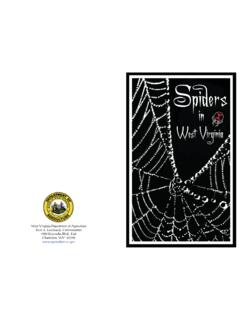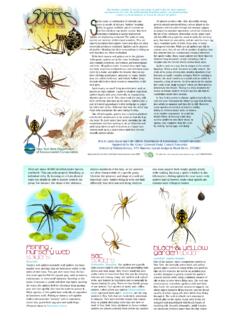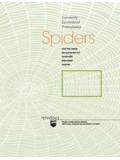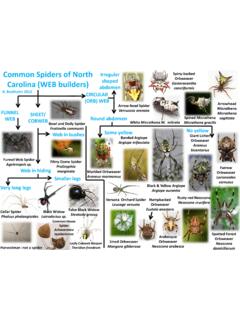Transcription of A Pocket Guide to Common Kansas Spiders
1 IA Pocket Guide toCommonKansas SpidersBy Hank GuariscoPhotos by Hank GuariscoFunded by Westar Energy Green Team, American Arachnological Societyand the Chickadee CheckoffPublished by the Friends of the Great Plains Nature CenteriiTable of ContentsIntroduction 2 Arachnophobia 3 spider Anatomy 4 House Spiders 5 Hunting Spiders 5 Venomous Spiders 6-7 spider Webs 8-9 Other Arachnids 9-12 Species accounts 13 Texas Brown Tarantula 14 Brown Recluse 15 Northern Black Widow 16 Southern & Western Black Widows 17-18 Woodlouse spider 19 Truncated Cellar spider 20 Elongated Cellar spider 21 Common Cellar spider 22 Checkered Cobweb Weaver 23 Quasi-social Cobweb spider 24 Carolina Wolf spider 25 Striped Wolf spider 26 Dotted Wolf spider 27 Western Lance spider 28 Common Nurseryweb spider 29 Tufted Nurseryweb spider 30 Giant Fishing spider 31 Six-spotted Fishing spider 32 Garden Ghost SpiderCover Photo: Cherokee Star-bellied Orbweaver 1 Eastern Funnelweb spider 33 Eastern and Western Parson Spiders 34 Garden Ghost spider 35 Bark Crab spider 36 Prairie Crab spider 37 Texas Crab spider 38 Black-banded Crab spider 39 Ridge-faced Flower spider 40 Striped Lynx spider 41 Common and Convict Zebra Spiders 42 Dimorphic Jumping spider 43 Bold Jumping spider 44 Apache Jumping spider 45 Prairie Jumping spider 46 Emerald Jumping spider 47 Bark Jumping spider 48 Puritan Pirate spider 49 Eastern and Four-lined Pirate Spiders 50 Orchard spider 51 Castleback Orbweaver 52 Triangulate Orbweaver 53 Common & Cherokee Star-bellied Orbweavers 54 Black & Yellow Garden spider 55 Banded Garden spider 56 Marbled Orbweaver 57 Eastern Arboreal Orbweaver 58 Western Arboreal Orbweaver 59 Furrow Orbweaver 60 Eastern Labyrinth Orbweaver 61 Giant Long-jawed Orbweaver 62 Silver Long-jawed Orbweaver 63 Bowl and Doily spider 64 Filmy Dome spider
2 66 References 67 Pocket Guides 68-69 Black-banded Crab Spider2 IntroductionThis is a Guide to the most Common Spiders found in Kansas . Spiders are one of the most successful groups on earth. Worldwide, there are over 42,000 species, and more than 3,800 of these live in the and Canada. Because of its central location and diversity of habitats, there are approximately 500 species in Kansas . Spiders attract attention by their unique silk webs and their proximity to houses and gardens. A few local Spiders have venomous bites; the Brown Recluse and black widows. This Guide also includes Common representatives of other arachnids (close relatives of Spiders ) found in Kansas . These include ticks, mites, daddy-long-legs, scorpions, pseudoscorpions, and solpugids. Like Spiders , they also have eight legs, except for larval ticks, which have six. Of this group, only scorpions are venomous. Daddy-long-legs are not venomous. They do not even possess venom glands. This is an urban legend that is most likely based on the different uses of the Common name, daddy-long-legs.
3 In the , it refers to members of the order Opiliones, also known as harvestmen. In other countries, this name refers to cellar Spiders , or even craneflies in Great Britain. Another example of a potentially misleading Common name is the funnel web spider . In Australia this refers to the very dangerous Australian funnel web, Atrax robustus, a relative of tarantulas. In the , this name refers to an entirely different family of Spiders (Agelenidae) that are harmless. Referring to Spiders and other animals by their scientific name is the best way to avoid people have an extreme fear of Spiders and other arachnids. They can t even look at a picture of one without cringing. Of course, a few Spiders can be harmful, but this fear is usually based on other factors: It s all those legs or It s just gross. Often it s a love-hate relationship. People are scared but also fascinated by them. By learning more about these reviled creatures, we can eventually distinguish harmful from harmless Spiders , and become more familiar with their interesting lives.
4 Then instead of instantly squashing one in our homes, we may realize it has an important role in nature, place a glass jar over it, slide a piece of paper under the jar, and release it outside. Arachnophobia created by Roger Holden of Magic AnatomySpiders have two major body parts: the cephalothorax and the abdomen, which are linked by a narrow tubular structure called a pedicel. The upper part of the cephalothorax is called the carapace. The carapace usually has six or eight eyes in two rows near the front end, as well as two jaws, each consisting of a base (chelicera) and a fang. The legs and small leg-like appendages near the mouth (pedipalps) are attached to the carapace. The abdomen contains most of the internal organs, such as the heart, book lungs, trachea, and reproductive organs. The trachea ends in a slit-like opening (spiracle) on the underside of the abdomen. In females and juveniles, the pedipalp remains a small leg-like appendage, but in males the end transforms into a sexual organ that may resemble a tiny boxing glove.
5 Upon reaching maturity, the male spins a small silk web, deposits a drop of sperm onto the web, and sucks it up into the bulbs of his pedipalps. Now he is ready to find a female spider and will use the pedipalps to mate with her. In those cases where more obvious anatomical distinctions are lacking, careful examination of the structures of the male pedipalp is needed to determine the species of a spider . spider Body (adapted from Biology of Spiders by Foelix 1982)5 House SpidersSome Spiders are frequently found in and around homes. It is useful to divide them into two groups: true house Spiders (synanthropes), and seasonally abundant Spiders . True house Spiders establish breeding populations in houses, can be found throughout the year, and have broad ranges since they are often accidently transported to new areas of the globe. Seasonally Common Spiders are Common in houses and the surrounding environment, especially at certain times of the year. They do not establish breeding populations in houses.
6 This Guide will note this distinction where SpidersHunting Spiders detect and overcome their prey without the use of webs. However, they still construct silk resting sacs and silk egg sacs. Resting sacs are used for resting, molting, hibernating and, by the female, often as a nest to guard the egg sac. Some hunting Spiders are sit-and-wait predators, while others actively search their environment for prey. Some of these active Spiders will supplement their diet by drinking nectar for a quick energy boost. Common hunting Spiders include: jumping Spiders , crab Spiders , wolf Spiders , fishing Spiders , lynx Spiders , ground Spiders , and pirate Spiders . Jumping Spiders have excellent vision and can see color. The brightly colored males perform elaborate courtship dances to attract the attention of females. Crab Spiders are the ultimate sit-and-wait predators. Some yellow or white species sit in flowers and pounce upon visiting insects, perhaps even larger than themselves. Over a period of several days, they can change color to match the color of the flower.
7 6 Venomous SpidersNearly all Spiders have venom glands, but a few families of Spiders have none, relying instead on their webbing and physical prowess to overcome and capture their prey. Although some people can have an allergic reaction to the bite of any spider possessing venom glands, there are only four Kansas Spiders whose bites are considered dangerous enough to require medical attention. These are the Brown Recluse and three species of black widow Spiders . The Brown Widow, a tropical species found across the globe, was discovered in the Wichita area several years ago. It is also venomous. It is a Common house spider that is easily transported, and has established populations in Florida, southern Texas, and southern California, but not in Kansas as of 2016. The bite of the Brown Recluse can cause mild to severe symptoms, which include tissue breakdown and the development of a necrotic lesion at the site of the bite that takes weeks or months to heal. Surgery is sometime required to remove dead tissue.
8 In rare cases, death has resulted from kidney failure. Luckily, the recluse s behavior matches its name, and will bite only if pressed against the skin. This usually occurs in bed or when putting on clothing that harbors the spider . Placing sticky traps in corners and closets is an effective way to both detect and decrease recluse populations. If bitten, the victim should preserve the spider in rubbing alcohol so that its identity can be verified by an expert. Home remedies that have been used by Kansans bitten by the Brown Recluse include: immediately applying a poultice made of crushed plantain (Plantago sp.) leaves, or a paste of water and ascorbic or citric acid (a crushed vitamin C tablet) to the bitten area. However, this statement is not to be construed as medical advice, and appropriate medical treatment should be sought if envenomated. 7 The venom of black and brown widows interferes with nerve transmission, and these spider bites produce serious symptoms involving the entire body.
9 The bite is very painful and increases in severity during the first 12 to 24 hours. Severe backaches and a board-like abdomen due to intense muscle contractions are coupled with restlessness and agitation. Some victims that didn t know they had been bitten have been misdiagnosed by emergency room physicians who believed they had appendicitis due to the board-like abdomen. There is an effective antivenin that can stop the venom s action and reverse the symptoms quite rapidly. A pregnant women bitten by a black widow in California was afraid of losing her unborn child. Her contractions ceased within 30 minutes after administering the antivenin. Supportive treatment includes administering calcium, magnesium, and pain medication. Brown Recluse8 spider WebsA unique characteristic of Spiders is their ability to produce elaborate silk webs of various designs. It is often possible to identify a spider to the family, genus, or even species level by examining the web. Besides providing a secure home for the spider , the web also functions as a prey-trapping device.
10 Some major web types include: orbwebs, funnelwebs, cobwebs, and sheetwebs. Two sheetweb weavers, the Bowl and Doily spider and the Filmy Dome spider , can be recognized by their unique webs (see page 65). Silk is produced by the spinnerets, which are located at the back of the abdomen. Web of Family DictynidaeCastleback spider OrbwebFunnelweb (Agelenopsis sp.)Cobweb (Tidarren sp.)9 Silk is also used to wrap prey and create sacs for hiding, molting or overwintering. Young Spiders of many species disperse into new habitats by climbing to a high point and releasing a long line of silk, which catches the breeze and carries the spiderlings away. This is called ArachnidsBesides Spiders , Kansas is the home of other types of Arachnids, including one species of scorpion, about a dozen species of daddy-long-legs (some of which actually have short legs), ticks, mites, pseudoscorpions, and a scorpion species is found under rocks throughout Kansas . It eats a variety of insects and Spiders .





